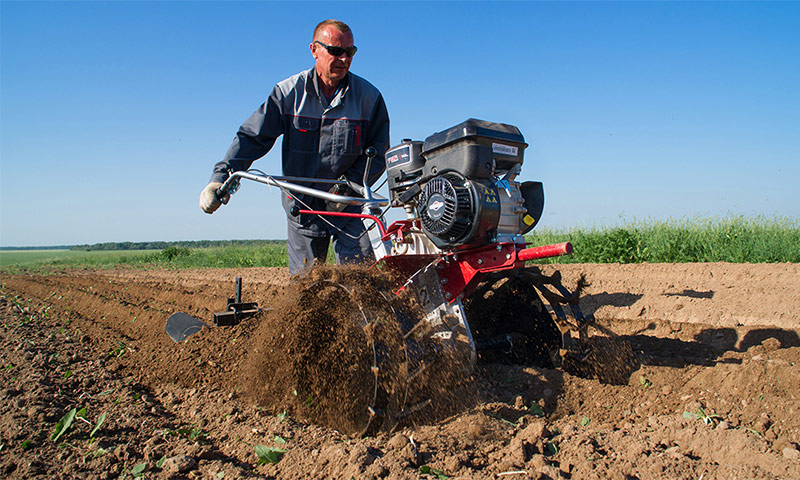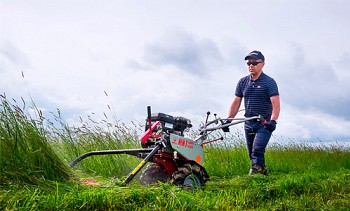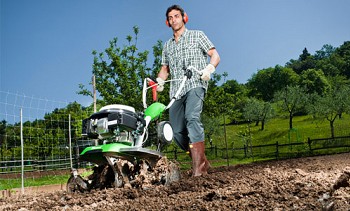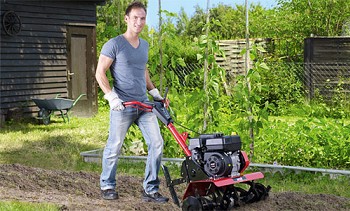Small-scale mechanization tools, which have become popular in recent decades, greatly simplify the lives of summer residents, farmers, and residents of villages and villages that have at their disposal certain areas of agricultural land. Cultivating the land and caring for crops requires less physical effort and time if you buy a walk-behind tractor or a cultivator.
These are relatively inexpensive machines based on gasoline engines, with which you can perform a wide range of operations for soil treatment, plant care and harvesting in areas from 10 - 15 hundred parts to 2-3 hectares. Most of these machines are distinguished by their robust design, ease of operation, economical fuel consumption and versatility.
With their help, you can perform: plowing; cultivation; cutting rows; hilling; weeding; harvesting potatoes; mowing grass; cleaning the yard and paths of snow ... And many more operations that previously required heavy physical labor. It is important only to determine the scope of the proposed work and choose the right technique. The first problem that arises when choosing this technique is a walk-behind tractor or a cultivator, what to choose for your needs. Further we will consider this problem in more detail.

Content:
What is the difference between a cultivator and a walk-behind tractor
 |  | |||||||
|---|---|---|---|---|---|---|---|---|
| Motocultivators | Motoblocks | |||||||
| Weight, kg | 20 - 60 | 70 - 120 | ||||||
| Power l from. | 3 - 6 | 7 - 12 and more | ||||||
| Frame design | The rigidity and massiveness of the frame depends on the power. | Massive, reinforced frame. | ||||||
| Transmission | Limited to one gear, it is possible to set the direction of rotation of the cutters. | There is a gearbox, at least 2 forward and 1 reverse gear. | ||||||
| PTO | ||||||||
| Air wheels | Only some models are equipped with air wheels. | As a rule, they are equipped with pneumatic wheels. | ||||||
| Milling | The main method of tillage. | It can be used, but it is not the main processing method. | ||||||
| Work with the hills | Heavy models will be able to work, but only on light soils. | They can work with double hills. | ||||||
| Work with a plow | Not fit. | They can process different types of soils. | ||||||
| Work with a potato digger | Not adapted | They can work with a potato digger. | ||||||
| Work with the mower, a snow blower and another active hitch |
Not fit. | Models equipped with a power take-off shaft can work. | ||||||
| Transport work | There is an opportunity to adapt for transport work, but there is no expediency. | It is possible to carry out transport work. | ||||||
Motocultivators

Very popular cars based mainly on gasoline engines. The power of the motors is 3 - 6 hp, and the weight of the unit reaches 60 kg. The mass range is quite significant - you can find cultivators weighing about 20 kg, and buy models that include the installation of special ballast weights that increase the total weight to 100 or more kilograms. This is required when working on heavy soils and performing certain operations, which will be discussed below.
The functionality of motor cultivators is quite limited - fluffing up the soil, weeding, inter-row cultivation, and in some cases - earthing up. The scope of use of cultivators weighing up to 50 kg is summer cottages and personal plots with an area of up to 15 - 20 hundred parts, flower beds, greenhouses.
The working body of the cultivator is a sectional rotary cutter with a width of 35 - 70 cm. Due to the removable sections, the cutter width can be changed, which is very convenient for processing different crops with different row spacing.The milling cutter is also the mover of the unit - catching on the soil, the cultivator pulls forward at a speed that is regulated by the gas handle.

Modern models of motor-cultivators can be equipped with gearboxes of variator or gear types with or without reverse. As a rule, gearboxes are installed on devices heavier than 50 kg. The number of gears in most models is not too large - 1 + 1 or 2 + 1.
Instead of milling cutters on heavy models, metal wheels with lugs can be installed. This makes it possible to use trailed implements - plows and hills. But practice shows that even heavy tractor cultivators are not able to cope with plowing, but they cultivate potatoes at an acceptable level of quality only on light soils, even in the case of preliminary processing of row-spacing with a mill.
Summarizing the information, it is safe to say that motocultivators have the right to life, and even have their own advantages over motoblocks, but only if they are used in small areas and inside artificial structures. The main operations that most motor cultivators cope with "excellent" - loosening the soil with a mill and processing row spacings.
Motoblocks

In a dispute that a cultivator or walk-behind tractor is better, one or the other side cannot be unequivocally taken. This is about the same as comparing a tracked tractor and a car. Each of the units has its own purpose and its own characteristics. If we compare the same operations, the walk-behind tractor copes with them more confidently than a cultivator, but instead it is more expensive, heavier, and consumes more fuel.
Motor blocks based on gasoline and diesel engines are produced in approximately equal proportions. Gasoline engines are installed on light and medium walk-behind tractors, weighing 50 - 150 kg, diesel engines - on a significant part of medium and heavy, the mass of which can reach 300 kg. The engine power of light motoblocks is about 6 hp, medium - up to 8 hp and heavy - 8 - 12, or even more horsepower.
The main difference between the walk-behind tractor and the cultivator is the presence of pneumatic tires and a power take-off shaft that allows you to connect a wide plume of attachments - the same cutter, mower, pump, wood splitter, etc. Pneumatic wheels are used both in transport and in working position.

Motoblocks of all kinds are equipped with full-fledged gearboxes with obligatory reverse speed. Medium and heavy walk-behind tractors can have up to 4-5 gears forward and 2 reverse. But most models have simpler transmissions with 2 to 3 forward and one reverse gear.
Starting the motor is carried out both manually and from an electric starter (for some models of a professional class). Motor-blocks confidently work with almost all types of agricultural implements. They can plow, cultivate, mow, dig potatoes. It is very convenient to use them as a vehicle - most of the walk-behind tractors are equipped with trailed carts with a loading capacity of 0.3 - 1 ton. The speed of the walk-behind tractor unit may exceed 12 km / h.
Medium and heavy versions of walk-behind tractors are equipped with a locking differential, which allows you to work on heavy soils, wet grass and move along blurred roads and arable land.
There are transitional models on the market that in their basic parameters resemble a walk-behind tractor and are heavy, have a gearbox, gearbox, but do not have a power take-off shaft. In fact, it is a wheeled tiller and often, it is difficult to understand the difference between a tiller or a walk-behind tractor. These are intermediate models that have absorbed all the best from both cars.

In which cases you can use the cultivator, and in which walk-behind tractor
The cultivator is an ideal machine for giving and a small site. Some European, American and Japanese models can be used for professional work in landscape design, gardening, greenhouse farming.They perfectly loosen the soil almost to the state of fine sand or flour, destroy weeds, and the possibility of changing the width of the milling makes them indispensable in gardening.
In their functionality, they are practically not inferior to light walk-behind tractors - there is not only the possibility of transporting a trailer, but few people use light walk-behind tractors as a vehicle.
If your land is cultivated and in the future you need to maintain its condition from year to year by milling, then a cultivator weighing 30 - 40 kg will be the best choice. For greenhouses, you can choose a cultivator model weighing 20 kg.

Motoblock is a universal tool that allows you to perform not only milling, but also various other operations. Therefore, if you only need cultivation, then you should not spend money on a walk-behind tractor.
A walk-behind tractor should be bought only if there is a site with an area of about 0.5 hectares, the need to connect active equipment and transport various agricultural, construction and household goods over short distances. Motoblocks, especially heavy ones, have the functionality of a mini-tractor.

In some cases, you can attach the cart to the tractor. To do this, you need to buy pneumatic wheels and a special hitch. However, this makes very little sense, the cultivator itself does not have such power, and due to the lack of increased gears, its speed of movement will be only 2 - 3 km / h.
If you plan to work with rear attachments such as a plow, potato digger, double hiller, then you can not do without a walk-behind tractor. At the same time, the heavier the walk-behind tractor will be, the easier it is to work with the rear attachments, but it is more difficult to perform milling. To work with the plow, you should take a closer look at walk-behind tractors weighing 100 - 120 kg.



In addition to cultivating land, the walk-behind tractor allows you to attach a mower for mowing grass. There are two types of such mowers - knife and rotary. They can be adapted for mowing hay, as well as for mowing the lawn.

In winter, a rotary snow blower can be attached to the walk-behind tractor and used for quick snow removal from the tracks around the house.

Recently, there has been a tendency to equip the walk-behind tractor with a front steering axle and turn it into a four-wheeled agricultural machine with delivery capacity and breadth of opportunities for servicing a private farm, park and communal services or a medium-sized garden and greenhouse.
When choosing the necessary equipment, first of all, it is recommended to focus on the amount and type of work for which it is purchased. It should also be remembered that the more powerful the walk-behind tractor or cultivator, the more difficult it is to drive. For retirees and women working in household plots, it is best to buy a medium-sized motor cultivator, and for full use in a commodity economy - a motor-block.



